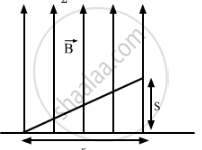Advertisements
Advertisements
प्रश्न
An electron is projected horizontally with a kinetic energy of 10 keV. A magnetic field of strength 1.0 × 10−7 T exists in the vertically upward direction.
(a) Will the electron deflect towards the right or left of its motion?
(b) Calculate the sideways deflection of the electron while travelling through 1 m. Make appropriate approximations.
उत्तर
Given:
The kinetic energy of the electron projected in the horizontal direction, K.E = 10 keV = 1.6 × 10−15 J
Magnetic field, B = 1 × 10−7 T
The direction of magnetic field is vertically upward.
(a) The direction can be found by the right-hand screw rule. So, the electron will be deflected towards left.
(b) Kinetic energy,
`K.E = 1/2mv^2`
`v = sqrt((K.Exx 2)/m)`
Magnetic force,
`vecF = q vecv xx vecB` ......(i)
and F = ma
Therefore, equation (i) will be
`a=(qvecvxx vecB)/m`
Applying equation of motion
`s = ut + 1/2 at^2`
t= Time taken to cross the magnetic field
As there is no force acting on the electron in the horizontal direction, the velocity of the electron remain constant in this direction.
So, the time taken to cross a distance of 1m in the horizontal direction in the magnetic field,
`t = (d)/(v_"horizontal")`
=` (1)/sqrt((2xxkxxE)/m`
= `(qvB)/(4xxK.E)`
`= 1/4 (1.6xx10^-(19) xx1xx10^-7xx sqrt(2 xx K. E)/m)/(10xx 10^-16)`
`= 0.148 xx 10^-3 m`
`= 0.01482 cm`
s = 0.0148 = 1.5 × 10−2 cm
APPEARS IN
संबंधित प्रश्न
Draw a neat labelled diagram for the construction of 'cyclotron'
State the principle of a cyclotron.
Show that the time period of revolution of particles in a cyclotron is independent of their speeds. Why is this property necessary for the operation of a cyclotron?
State the underlying principle of a cyclotron. Write briefly how this machine is used to accelerate charged particles to high energies
Deduce an expression for the frequency of revolution of a charged particle in a magnetic field and show that it is independent of velocity or energy of the particle.
An α-particle and a proton are released from the centre of the cyclotron and made to accelerate.
(i) Can both be accelerated at the same cyclotron frequency?
Give reason to justify your answer.
(ii) When they are accelerated in turn, which of the two will have higher velocity at the exit slit of the does?
Which of the following particles will describe the smallest circle when projected with the same velocity perpendicular to a magnetic field?
If a charged particle kept at rest experiences an electromagnetic force,
(a) there must be an electric field
(b) there must be a magnetic field
(c) both fields cannot be zero
(d) both fields can be non-zero
(a) An electron moves along a circle of radius 1 m in a perpendicular magnetic field of strength 0.50 T. What would be its speed? Is it reasonable? (b) If a proton moves along a circle of the same radius in the same magnetic field, what would be its speed?
Answer the following question.
State the underlying principle of a cyclotron. Explain its working with the help of a schematic diagram. Obtain the expression for cyclotron frequency.
A charged particle is moving in a cyclotron, what effect on the radius of path of this charged particle will occur when the frequency of the ratio frequency field is doubled?
Which of the following is not correct about cyclotron?
An aircraft executes a horizontal loop of radius 1.00 km with a steady speed of 900 km/h. Its centripetal acceleration is ______.
A particle of mass m is moving in a circular path of constant radius r such that, its centripetal acceleration ac is varying with time t as ac = k2rt2, where k is a constant. The power delivered to the particle by the forces acting on it is ______.
The life time of muon in the rest frame is 2 × 10-6 sec. A beam of muons emerges from a cyclotron with velocity where c is the velocity of light The mean life of muons observed in the laboratory frame will be ______.
A cyclotron can accelerate ______.
In a cyclotron, a charged particle ______.
